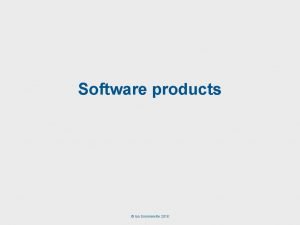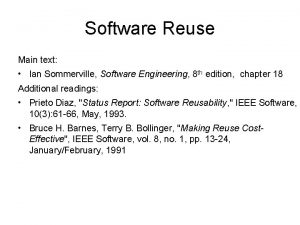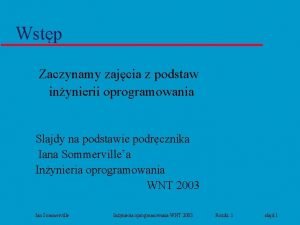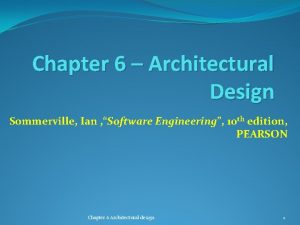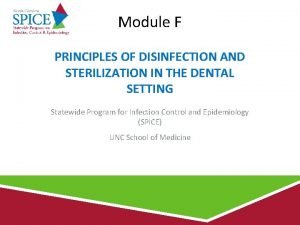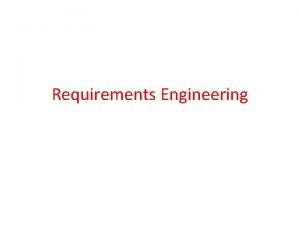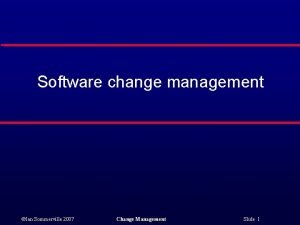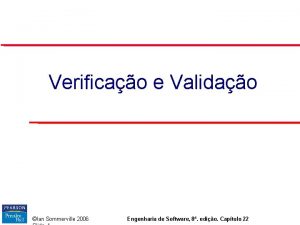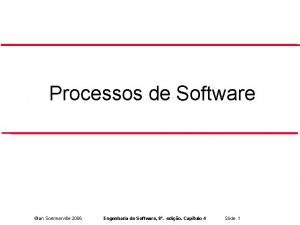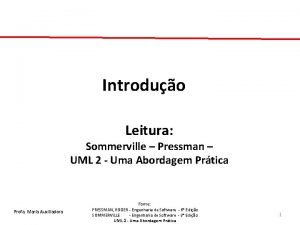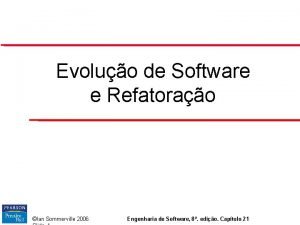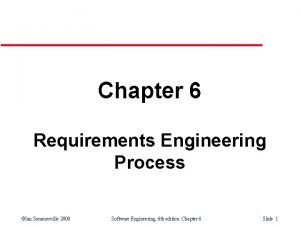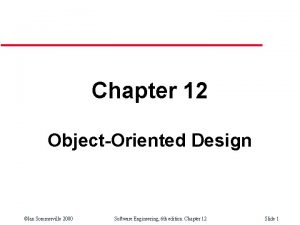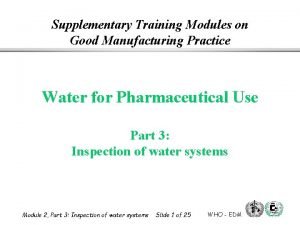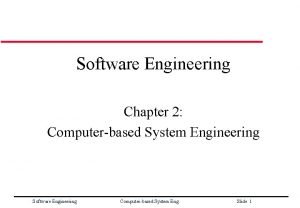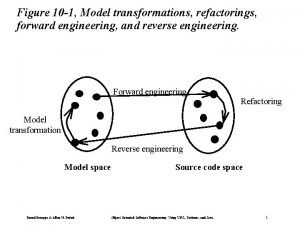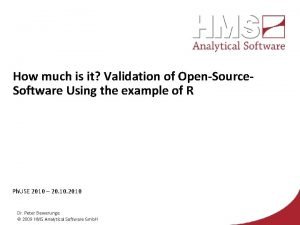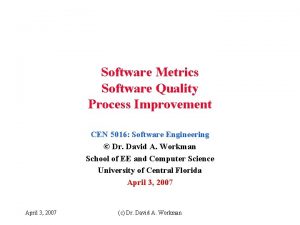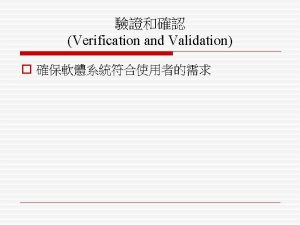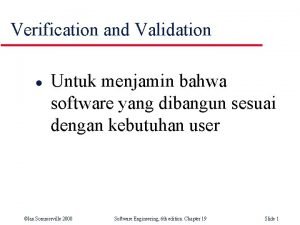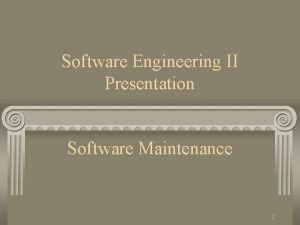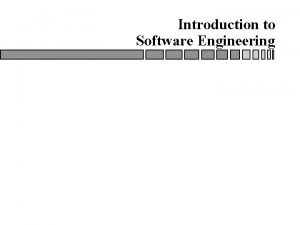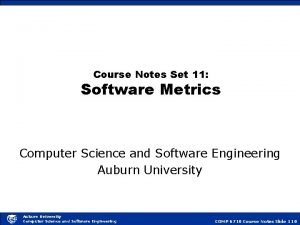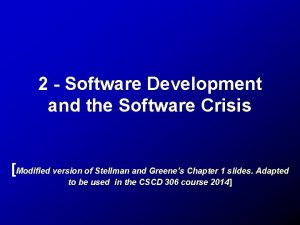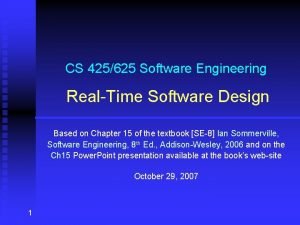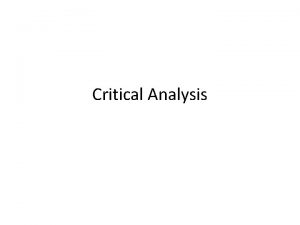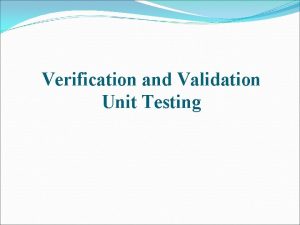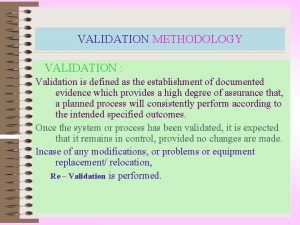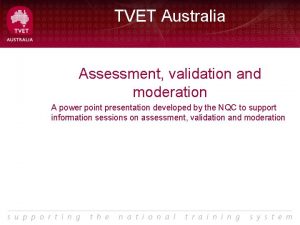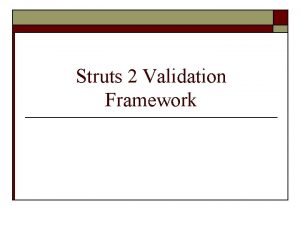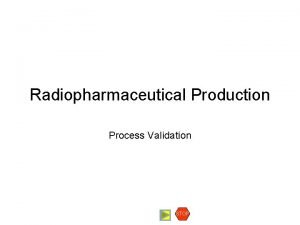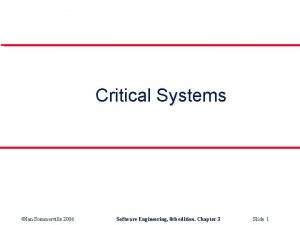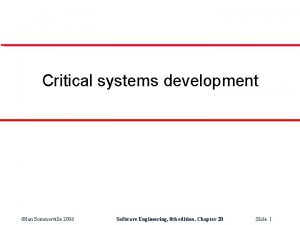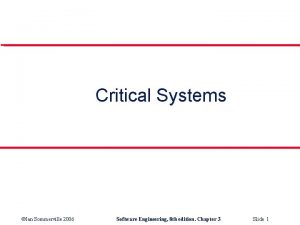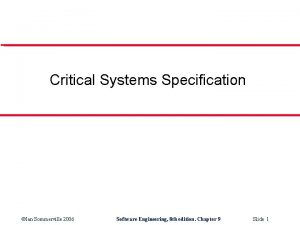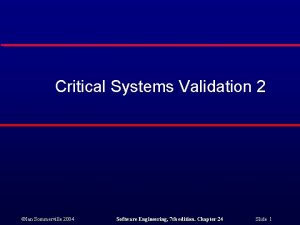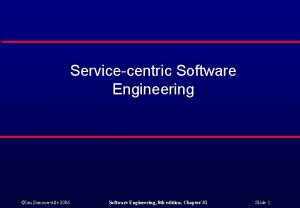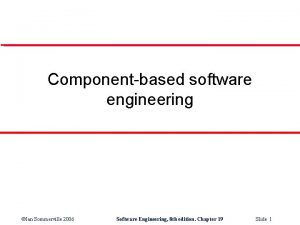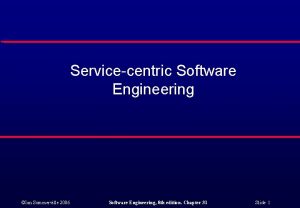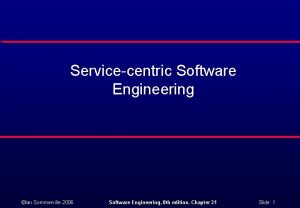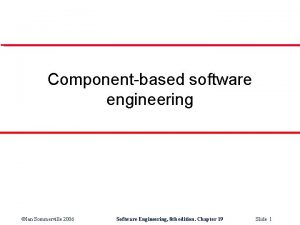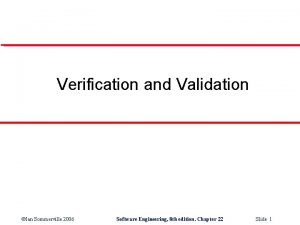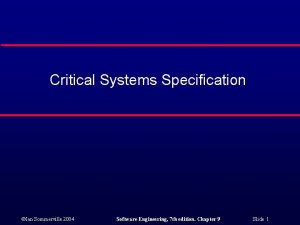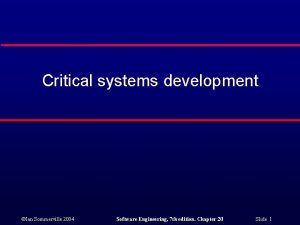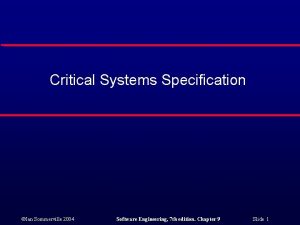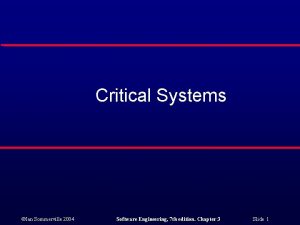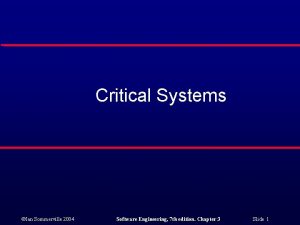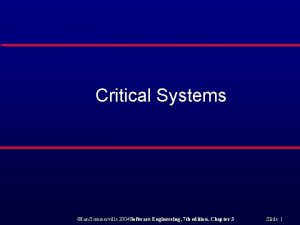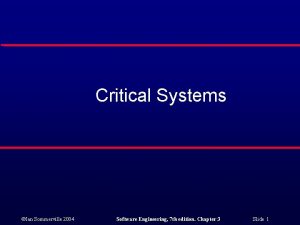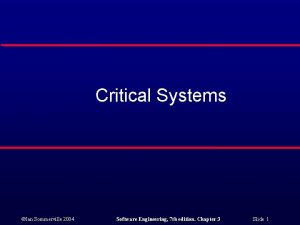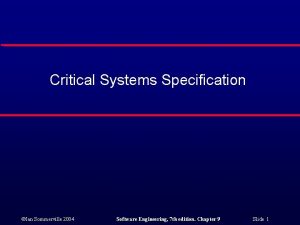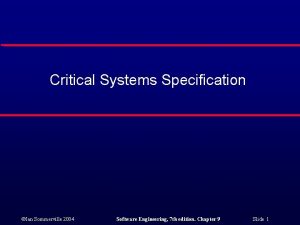Critical Systems Validation Ian Sommerville 2006 Software Engineering













































- Slides: 45

Critical Systems Validation ©Ian Sommerville 2006 Software Engineering, 8 th edition. Chapter 24 Slide 1

Objectives l l To explain how system reliability can be measured and how reliability growth models can be used for reliability prediction To describe safety arguments and how these are used To discuss the problems of safety assurance To introduce safety cases and how these are used in safety validation ©Ian Sommerville 2006 Software Engineering, 8 th edition. Chapter 24 Slide 2

Topics covered l l Reliability validation Safety assurance Security assessment Safety and dependability cases ©Ian Sommerville 2006 Software Engineering, 8 th edition. Chapter 24 Slide 3

Validation of critical systems l The verification and validation costs for critical systems involves additional validation processes and analysis than for non-critical systems: • • The costs and consequences of failure are high so it is cheaper to find and remove faults than to pay for system failure; You may have to make a formal case to customers or to a regulator that the system meets its dependability requirements. This dependability case may require specific V & V activities to be carried out. ©Ian Sommerville 2006 Software Engineering, 8 th edition. Chapter 24 Slide 4

Validation costs l l Because of the additional activities involved, the validation costs for critical systems are usually significantly higher than for noncritical systems. Normally, V & V costs take up more than 50% of the total system development costs. ©Ian Sommerville 2006 Software Engineering, 8 th edition. Chapter 24 Slide 5

Reliability validation l l l Reliability validation involves exercising the program to assess whether or not it has reached the required level of reliability. This cannot normally be included as part of a normal defect testing process because data for defect testing is (usually) atypical of actual usage data. Reliability measurement therefore requires a specially designed data set that replicates the pattern of inputs to be processed by the system. ©Ian Sommerville 2006 Software Engineering, 8 th edition. Chapter 24 Slide 6

The reliability measurement process ©Ian Sommerville 2006 Software Engineering, 8 th edition. Chapter 24 Slide 7

Reliability validation activities l l Establish the operational profile for the system. Construct test data reflecting the operational profile. Test the system and observe the number of failures and the times of these failures. Compute the reliability after a statistically significant number of failures have been observed. ©Ian Sommerville 2006 Software Engineering, 8 th edition. Chapter 24 Slide 8

Statistical testing l l l Testing software for reliability rather than fault detection. Measuring the number of errors allows the reliability of the software to be predicted. Note that, for statistical reasons, more errors than are allowed for in the reliability specification must be induced. An acceptable level of reliability should be specified and the software tested and amended until that level of reliability is reached. ©Ian Sommerville 2006 Software Engineering, 8 th edition. Chapter 24 Slide 9

Reliability measurement problems l Operational profile uncertainty • l High costs of test data generation • l The operational profile may not be an accurate reflection of the real use of the system. Costs can be very high if the test data for the system cannot be generated automatically. Statistical uncertainty • You need a statistically significant number of failures to compute the reliability but highly reliable systems will rarely fail. ©Ian Sommerville 2006 Software Engineering, 8 th edition. Chapter 24 Slide 10

Operational profiles l l An operational profile is a set of test data whose frequency matches the actual frequency of these inputs from ‘normal’ usage of the system. A close match with actual usage is necessary otherwise the measured reliability will not be reflected in the actual usage of the system. It can be generated from real data collected from an existing system or (more often) depends on assumptions made about the pattern of usage of a system. ©Ian Sommerville 2006 Software Engineering, 8 th edition. Chapter 24 Slide 11

An operational profile ©Ian Sommerville 2006 Software Engineering, 8 th edition. Chapter 24 Slide 12

Operational profile generation l l l Should be generated automatically whenever possible. Automatic profile generation is difficult for interactive systems. May be straightforward for ‘normal’ inputs but it is difficult to predict ‘unlikely’ inputs and to create test data for them. ©Ian Sommerville 2006 Software Engineering, 8 th edition. Chapter 24 Slide 13

Reliability prediction l l A reliability growth model is a mathematical model of the system reliability change as it is tested and faults are removed. It is used as a means of reliability prediction by extrapolating from current data • • l Simplifies test planning and customer negotiations. You can predict when testing will be completed and demonstrate to customers whether or not the reliability growth will ever be achieved. Prediction depends on the use of statistical testing to measure the reliability of a system version. ©Ian Sommerville 2006 Software Engineering, 8 th edition. Chapter 24 Slide 14

Equal-step reliability growth ©Ian Sommerville 2006 Software Engineering, 8 th edition. Chapter 24 Slide 15

Observed reliability growth l l The equal-step growth model is simple but it does not normally reflect reality. Reliability does not necessarily increase with change as the change can introduce new faults. The rate of reliability growth tends to slow down with time as frequently occurring faults are discovered and removed from the software. A random-growth model where reliability changes fluctuate may be a more accurate reflection of real changes to reliability. ©Ian Sommerville 2006 Software Engineering, 8 th edition. Chapter 24 Slide 16

Random-step reliability growth ©Ian Sommerville 2006 Software Engineering, 8 th edition. Chapter 24 Slide 17

Growth model selection l l Many different reliability growth models have been proposed. There is no universally applicable growth model. Reliability should be measured and observed data should be fitted to several models. The best-fit model can then be used for reliability prediction. ©Ian Sommerville 2006 Software Engineering, 8 th edition. Chapter 24 Slide 18

Reliability prediction ©Ian Sommerville 2006 Software Engineering, 8 th edition. Chapter 24 Slide 19

Safety assurance l Safety assurance and reliability measurement are quite different: • • Within the limits of measurement error, you know whether or not a required level of reliability has been achieved; However, quantitative measurement of safety is impossible. Safety assurance is concerned with establishing a confidence level in the system. ©Ian Sommerville 2006 Software Engineering, 8 th edition. Chapter 24 Slide 20

Safety confidence l l Confidence in the safety of a system can vary from very low to very high. Confidence is developed through: • • • Past experience with the company developing the software; The use of dependable processes and process activities geared to safety; Extensive V & V including both static and dynamic validation techniques. ©Ian Sommerville 2006 Software Engineering, 8 th edition. Chapter 24 Slide 21

Safety reviews l l l Review for correct intended function. Review for maintainable, understandable structure. Review to verify algorithm and data structure design against specification. Review to check code consistency with algorithm and data structure design. Review adequacy of system testing. ©Ian Sommerville 2006 Software Engineering, 8 th edition. Chapter 24 Slide 22

Review guidance l l Make software as simple as possible. Use simple techniques for software development avoiding error-prone constructs such as pointers and recursion. Use information hiding to localise the effect of any data corruption. Make appropriate use of fault-tolerant techniques but do not be seduced into thinking that fault-tolerant software is necessarily safe. ©Ian Sommerville 2006 Software Engineering, 8 th edition. Chapter 24 Slide 23

Safety arguments l l l Safety arguments are intended to show that the system cannot reach in unsafe state. These are weaker than correctness arguments which must show that the system code conforms to its specification. They are generally based on proof by contradiction • • l Assume that an unsafe state can be reached; Show that this is contradicted by the program code. A graphical model of the safety argument may be developed. ©Ian Sommerville 2006 Software Engineering, 8 th edition. Chapter 24 Slide 24

Construction of a safety argument l l Establish the safe exit conditions for a component or a program. Starting from the END of the code, work backwards until you have identified all paths that lead to the exit of the code. Assume that the exit condition is false. Show that, for each path leading to the exit that the assignments made in that path contradict the assumption of an unsafe exit from the component. ©Ian Sommerville 2006 Software Engineering, 8 th edition. Chapter 24 Slide 25

Insulin delivery code ©Ian Sommerville 2006 Software Engineering, 8 th edition. Chapter 24 Slide 26

Safety argument model ©Ian Sommerville 2006 Software Engineering, 8 th edition. Chapter 24 Slide 27

Program paths l Neither branch of if-statement 2 is executed • l then branch of if-statement 2 is executed • l current. Dose = 0. else branch of if-statement 2 is executed • l Can only happen if Current. Dose is >= minimum. Dose and <= max. Dose. current. Dose = max. Dose. In all cases, the post conditions contradict the unsafe condition that the dose administered is greater than max. Dose. ©Ian Sommerville 2006 Software Engineering, 8 th edition. Chapter 24 Slide 28

Process assurance l l Process assurance involves defining a dependable process and ensuring that this process is followed during the system development. As discussed in Chapter 20, the use of a safe process is a mechanism for reducing the chances that errors are introduced into a system. • • Accidents are rare events so testing may not find all problems; Safety requirements are sometimes ‘shall not’ requirements so cannot be demonstrated through testing. ©Ian Sommerville 2006 Software Engineering, 8 th edition. Chapter 24 Slide 29

Safety related process activities l l l Creation of a hazard logging and monitoring system. Appointment of project safety engineers. Extensive use of safety reviews. Creation of a safety certification system. Detailed configuration management (see Chapter 29). ©Ian Sommerville 2006 Software Engineering, 8 th edition. Chapter 24 Slide 30

Hazard analysis l l l Hazard analysis involves identifying hazards and their root causes. There should be clear traceability from identified hazards through their analysis to the actions taken during the process to ensure that these hazards have been covered. A hazard log may be used to track hazards throughout the process. ©Ian Sommerville 2006 Software Engineering, 8 th edition. Chapter 24 Slide 31

Hazard log entry ©Ian Sommerville 2006 Software Engineering, 8 th edition. Chapter 24 Slide 32

Run-time safety checking l l During program execution, safety checks can be incorporated as assertions to check that the program is executing within a safe operating ‘envelope’. Assertions can be included as comments (or using an assert statement in some languages). Code can be generated automatically to check these assertions. ©Ian Sommerville 2006 Software Engineering, 8 th edition. Chapter 24 Slide 33

Insulin administration with assertions ©Ian Sommerville 2006 Software Engineering, 8 th edition. Chapter 24 Slide 34

Security assessment l l l Security assessment has something in common with safety assessment. It is intended to demonstrate that the system cannot enter some state (an unsafe or an insecure state) rather than to demonstrate that the system can do something. However, there are differences • • Safety problems are accidental; security problems are deliberate; Security problems are more generic - many systems suffer from the same problems; Safety problems are mostly related to the application domain ©Ian Sommerville 2006 Software Engineering, 8 th edition. Chapter 24 Slide 35

Security validation l Experience-based validation • l Tool-based validation • l Various security tools such as password checkers are used to analyse the system in operation. Tiger teams • l The system is reviewed analysed against the types of attack that are known to the validation team. A team is established whose goal is to breach the security of the system by simulating attacks on the system. Formal verification • The system is verified against a formal security specification. ©Ian Sommerville 2006 Software Engineering, 8 th edition. Chapter 24 Slide 36

Security checklist ©Ian Sommerville 2006 Software Engineering, 8 th edition. Chapter 24 Slide 37

Safety and dependability cases l l Safety and dependability cases are structured documents that set out detailed arguments and evidence that a required level of safety or dependability has been achieved. They are normally required by regulators before a system can be certified for operational use. ©Ian Sommerville 2006 Software Engineering, 8 th edition. Chapter 24 Slide 38

The system safety case l l It is now normal practice for a formal safety case to be required for all safety-critical computer-based systems e. g. railway signalling, air traffic control, etc. A safety case is: • l A documented body of evidence that provides a convincing and valid argument that a system is adequately safe for a given application in a given environment. Arguments in a safety or dependability case can be based on formal proof, design rationale, safety proofs, etc. Process factors may also be included. ©Ian Sommerville 2006 Software Engineering, 8 th edition. Chapter 24 Slide 39

Components of a safety case ©Ian Sommerville 2006 Software Engineering, 8 th edition. Chapter 24 Slide 40

Argument structure ©Ian Sommerville 2006 Software Engineering, 8 th edition. Chapter 24 Slide 41

Insulin pump argument ©Ian Sommerville 2006 Software Engineering, 8 th edition. Chapter 24 Slide 42

Claim hierarchy ©Ian Sommerville 2006 Software Engineering, 8 th edition. Chapter 24 Slide 43

Key points l l l Reliability measurement relies on exercising the system using an operational profile - a simulated input set which matches the actual usage of the system. Reliability growth modelling is concerned with modelling how the reliability of a software system improves as it is tested and faults are removed. Safety arguments or proofs are a way of demonstrating that a hazardous condition can never occur. ©Ian Sommerville 2006 Software Engineering, 8 th edition. Chapter 24 Slide 44

Key points l l l It is important to have a dependable process for safety-critical systems development. The process should include hazard identification and monitoring activities. Security validation may involve experiencebased analysis, tool-based analysis or the use of ‘tiger teams’ to attack the system. Safety cases collect together the evidence that a system is safe. ©Ian Sommerville 2006 Software Engineering, 8 th edition. Chapter 24 Slide 45
 Engineering software products ian sommerville
Engineering software products ian sommerville Simple aspect example
Simple aspect example Inżynieria oprogramowania ian sommerville
Inżynieria oprogramowania ian sommerville Sommerville software engineering slides
Sommerville software engineering slides Critical semi critical and non critical instruments
Critical semi critical and non critical instruments Spaulding classification
Spaulding classification Dicapine
Dicapine Elegant systems
Elegant systems Initiating the requirements engineering process
Initiating the requirements engineering process Change management in software testing
Change management in software testing Sommerville
Sommerville Sommerville
Sommerville Sommerville
Sommerville Sommerville
Sommerville Sommerville
Sommerville Sommerville
Sommerville Sommerville
Sommerville Elaine sommerville
Elaine sommerville Damian sommerville
Damian sommerville Validation of water systems for pharmaceutical use
Validation of water systems for pharmaceutical use System procurement process in software engineering
System procurement process in software engineering Forward engineering in software engineering
Forward engineering in software engineering Software validation example
Software validation example Software metrics validation
Software metrics validation V model verification and validation
V model verification and validation A software verification and validation method. section 19
A software verification and validation method. section 19 Software verification and validation plan
Software verification and validation plan Data validation software
Data validation software Software maintenance process models ppt
Software maintenance process models ppt Who invented software engineering
Who invented software engineering What is software metrics in software engineering
What is software metrics in software engineering Types of software crisis
Types of software crisis Software metrics example
Software metrics example Real time software design in software engineering
Real time software design in software engineering Software design fundamentals in software engineering
Software design fundamentals in software engineering Compare non-critical readers with critical readers.
Compare non-critical readers with critical readers. 4 p's of management spectrum
4 p's of management spectrum Forward and reverse engineering
Forward and reverse engineering Asp.net request validation bypass
Asp.net request validation bypass Is unit testing verification or validation
Is unit testing verification or validation Validationrule wpf
Validationrule wpf Prospective validation
Prospective validation Validation and moderation service
Validation and moderation service Twic card authentication & validation
Twic card authentication & validation Struts validation
Struts validation Master validation plan
Master validation plan
